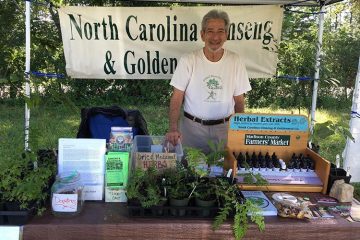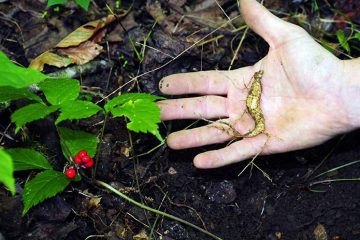Farming Ginseng in the Woods: A Sustainable Forest Cash Crop
Reported in New Life Journal,
Healing & Whole Foods News & Information in the Appalachians
www.newlifejournal.com
This is a revolutionary concept: to farm in the woods, without chemicals and without tractors. It recognizes that the last great hidden resource is our north-facing slope in our hardwood mountains. The lumber industry would like us to think that the only use and income for landowners for these magical, deep hardwood coves is to cut the timber every third generation. This myth is with us today.
The other myth is that wildcrafting ginseng brings easy money and big rewards. All you have to do is ask a ‘sang hunter how long it took to get over 400 roots to make a pound in the year 2000, and you will find that the wild ginseng is disappearing fast. Wildcrafting also includes knowing how to dig the ginseng correctly, clean it right and dry it properly. Both current day logging practices and wildcrafting are not sustainable in the new millennium. Chemical cultivation of ginseng in mono-cultured plots, either under shade cloth or in the woods, is not sustainable either, in my opinion.
Cultivation to me means spraying the ginseng with fungicides. This is not a healthy method, as the ginseng root absorbs the chemical where it becomes a residue. According to Bob Beyfuss, NY State Ginseng Specialist, “Ginseng worldwide is the most heavily sprayed plant on the planet, next to cotton.” I would add to the statement, “We do not eat cotton.” The fact is that heavily sprayed cultivated ginseng nets $18 per pound, while wild, chemical-free ginseng in the year 2000-2001 is fetching $350 to $380 a pound.
Examining Your Property.
Let’s take a look at what prerequisites you need to grow ginseng. Consider first the habitat for American ginseng. If your property has the following attributes, you should seriously consider growing native medicinal herbs. This could lead you not only to saving endangered plants, but also to making a profit from your effort. Ginseng and its friends live best in moist, dark, hardwood coves. A northern or eastern exposure is best for growing because it reduces summer heat and maintains moisture. The ginseng seed, unlike other seeds, cannot dry out, or it will die. On the north-facing slope, there are two main ecosystems to note.
The first is the rhododendron, mountain laurel and hemlock community with their plant companions, pipsissewa, galax, and wintergreen. The rhododendron and mountain laurel have a toxic leaf which causes problems by eliminating many other plants, including ginseng. So you do not want to plant down the hill from this acid-loving community. Plant above these trees.
The other hardwood community to look for and plant in is the poplar, beech, maple, dogwood, oak community with many companion plants, like trillium, cohosh, jack-in-the-pulpit, solomon seal, goldenseal, and bloodroot, to name a few. Ginseng studies show a good growing habitat in a pH that is 5.5 to 6.0. Tests in New York have shown that calcium is beneficial for ginseng growth and that maple trees can give off calcium. While maple trees may be good for ginseng growth, they are not beneficial for goldenseal. The maple tree roots which are close to the surface compete for nutrients and space with goldenseal, but not ginseng which has a tap root.
Checking Soil Requirements.
Ginseng requires a well-drained soil, which means a steep to moderate slope. Too much standing water will generate diseases and cause the roots to rot. Creating terraces by taking downed lumber and putting it on the up-hill side will create a flatter area to plant but will not cause the water to stand. These terraces are desirable for keeping the soil from eroding. One of the most important elements for good ginseng growth is the soil. Soil testing is essential. I consider myself a convert of Dr. Elaine Ingham from Oregon State University, author of the “Soil Foods Web” concept. To simplify here, soil in the woods and soil in the sun garden are different. Woods-soil is made at my farm from 75% bark mulch that has been composted and 25% veggie compost (which can also be horse, chicken, turkey manure or worm castings). I would like to use hardwood mulch but pine bark mulched compost is all I can get. This will give you a dark, moist medium in which to plant the seeds or roots.
Planting.
Ginseng is planted from seeds and roots in the spring or fall of the year. September through October is the best time to plant, just before the leaves come down. Density of planting is very important. There needs to be space enough to ensure airflow, to reduce competition for moisture, nutrients and sunlight, and to help control the spread of disease. A minimum of 1 1/2 feet between plants is needed, and three to five feet is recommended, in a mixed bed with other companion plants and ferns. Broadcasting seeds usually have lower germination rates since the seeds tend to dry out. Some people rake, broadcast and cover. However, this usually is in a mono-cultured area and will require chemical spraying for the minimum seven to ten year growth period or thinning the bed in the spring.
For best planting success, consider planting in the third quarter of the moon in the signs of Cancer, Scorpio or Pisces, with Cancer being the strongest sign. The next best signs to use are Taurus or Capricorn. The University of West Virginia has studied ginseng seed planting depth, and they have concluded it is optimum at two centimeters, which is between 1/2 inch and 3/4 of an inch. Roots planted in the fall should have the bud just below the surface of the earth. Transplanting roots is best in the early spring. The summer is never a good time to move or harvest ginseng.
Mulching.
Mulching is a very important step which provides protection for the plants. Leaves normally provide enough mulch naturally where moisture will be retained for a longer period of time and the temperature of the soil will remain cool. In addition, since mulch is constantly decaying, it leaves a natural fertilizer in the soil. If you are planting in the spring or after the leaves fall in the autumn, mulching should be applied to the beds immediately after planting.
Pest Control.
The best way to control pests and disease is through growing healthy plants. Healthy plants need great soil. Much of the topsoil in the mountains is at the mouth of the Mississippi River. Plant diseases caused by fungi are one of the primary limitations to ginseng production. The fungi are borne by soil, air, and water. Today’s prevention is by spacing and proper drainage. New studies indicate that sprays made from either Horsetail in the spring or Goldenseal in the fall can help with fungal problems. In certain areas deer, wild turkey, livestock, ground squirrels, squirrels,voles, mice, and slugs can be a problem. However, all of these have management solutions.
Robert Eidus runs the North Carolina Ginseng and Goldenseal Company in Marshall, NC.
Contact him at 828-649-3536.






